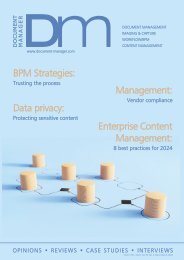NC Feb-Mar 2023
You also want an ePaper? Increase the reach of your titles
YUMPU automatically turns print PDFs into web optimized ePapers that Google loves.
CASE STUDY<br />
BIGTWIN HAS A BIG IMPACT AT CERN<br />
SUPERMICRO SERVERS ENABLE FASTER AND MORE COMPLEX<br />
SIMULATIONS AT CERN DATA CENTRE<br />
CERN, the European Organisation for<br />
Nuclear Research, operates the largest<br />
particle physics laboratory in the world.<br />
It's where researchers are uncovering what the<br />
universe consists of and how it works. At<br />
CERN, physicists and engineers use extremely<br />
complex scientific instruments, including the<br />
largest and most powerful particle accelerator<br />
in the world - the Large Hadron Collider<br />
(LHC). These studies into subatomic particles<br />
are advancing the boundaries of human<br />
knowledge by delving into the smallest<br />
building blocks of our universe. Many of the<br />
discoveries already made at CERN have had a<br />
powerful impact on several areas of everyday<br />
life, ranging from medicine to computing.<br />
As such, this is one of the most highly<br />
demanding and challenging computing<br />
environments in research. The World Wide<br />
Web was originally conceived and developed<br />
at CERN to meet the demand for automated<br />
information-sharing between scientists in<br />
universities and institutes dotted around the<br />
world. From software development to data<br />
processing and storage, networks, support for<br />
the LHC and non-LHC experimental<br />
programmes, automation and controls, as well<br />
as services for the accelerator complex and for<br />
the whole laboratory and its users, computing<br />
is at the heart of CERN's infrastructure.<br />
As a long-standing supplier to CERN,<br />
Supermicro provides accelerated enterprise<br />
computing technology that supports cuttingedge<br />
explorations in particle physics. As the<br />
search for understanding the universe's origins<br />
expands, new computing resources are<br />
constantly being evaluated and updated.<br />
The partnership between CERN and<br />
Supermicro serves to introduce new<br />
technologies to the high-performance compute<br />
cluster that processes data from the LHC.<br />
CERN scientists continue to explore enterprise<br />
innovations for CERN in collaboration with<br />
other global technology manufacturers.<br />
ADDING COMPUTE POWER WHILE<br />
MONITORING POWER CONSUMPTION<br />
To understand the results of the research<br />
experiments conducted by scientists and<br />
engineers at CERN, a significant amount of<br />
computing power is required. Therefore, it<br />
must be updated with the latest advancements<br />
in server, storage, and networking<br />
technologies, while keeping an eye on the<br />
total power consumption of the entire<br />
computing environment.<br />
CERN's infrastructure technical team worked<br />
meticulously over many months before any<br />
procurement in assessing the market for the<br />
latest technological advances. It is a<br />
qualification process that, although it can be<br />
very time-consuming, is an absolute necessity<br />
in keeping CERN at the forefront of global<br />
scientific research and, more importantly,<br />
allows for collaboration with suitable partners<br />
to assess solutions around performance, cost,<br />
operational costs, power, density, and so on.<br />
CERN selected the Supermicro AMD BigTwin<br />
A+ 2124BT-HNTR server following a lengthy<br />
evaluation process. As a result, CERN<br />
acquired over 900 Supermicro BigTwin<br />
systems, each with four nodes, for a total of<br />
approximately 3,600 server nodes. Many types<br />
of simulations and workloads take place at<br />
CERN. Most of them are used for running<br />
batch computing jobs related to physics-event<br />
reconstruction, data analysis, and simulation.<br />
In addition, part of them is used as front-ends<br />
to disk storage, collecting physics data from<br />
the experiments.<br />
Supermicro BigTwin servers are smart yet<br />
affordable investments for enterprises and<br />
institutions that need to build, expand, or<br />
future-proof advanced computing<br />
infrastructures. The high-performance, highdensity<br />
systems feature optimum airflow for<br />
energy-efficient cooling, easy maintenance,<br />
and high availability with hot-swappable nodes<br />
and redundant power supply modules.<br />
HIGH DENSITY RESULTS IN LOWER<br />
POWER CONSUMPTION<br />
CERN saw an increase in the performance of<br />
many simulation applications. In addition, with<br />
the high density of the Supermicro BigTwin<br />
systems with AMD EPYC processors, the power<br />
usage was lower than expected due to the<br />
shared cooling and power systems. With the<br />
AMD EPYC 7XXX CPU, applications ran faster<br />
than previous generations of CPUs, helping<br />
scientists perform more research to understand<br />
more about the world we live in.<br />
"We have worked alongside Supermicro for<br />
many years, and their attention to the design<br />
and engineering of the Supermicro BigTwin<br />
architecture has constantly increased.<br />
Thousands of compute nodes of the latest<br />
AMD EPYC based Supermicro BigTwin<br />
platform were deployed in the CERN<br />
computing facilities. This illustrates the highquality<br />
of these systems, both in terms of<br />
performance and reliability", said Eric<br />
Bonfillou, CERN IT Facility Planning and<br />
Procurement. <strong>NC</strong><br />
WWW.NETWORKCOMPUTING.CO.UK FEBRUARY/MARCH <strong>2023</strong> 21<br />
NETWORKcomputing<br />
@<strong>NC</strong>MagAndAwards

















